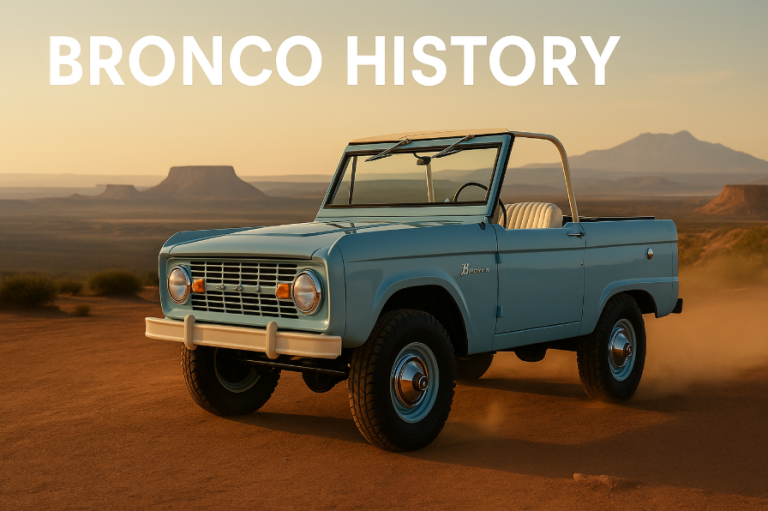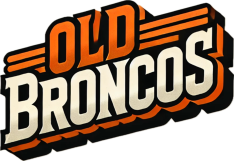Generation 1: The Original Ford Bronco (1966–1977)
From the U13 Roadster to the V8-powered U15 Wagon, Gen 1 set the standard for off-road freedom.

The first-generation Ford Bronco, built from 1966 through 1977, was designed as a direct competitor to the Jeep CJ and International Scout. With three body styles, a tight 92-inch wheelbase, and a rugged chassis, it quickly built a reputation for off-road capability. Later years introduced V8 power, optional power steering, and automatic transmissions—making it a legend that still dominates vintage 4×4 culture.
| Body Styles | Engine Options | Key Features |
|---|---|---|
| U13 Roadster, U14 Half-Cab, U15 Wagon | 170 I6, 200 I6, 289 V8, 302 V8 | Coil front suspension, removable doors (Roadster), Dana axles, 3-speed manual |
1966 Ford Bronco
The original Bronco. Launched with three body styles—Roadster, Half-Cab, and Wagon—and a 170 inline-6 engine. Iconic "eyebrow" grille and early collector rarity.
Explore 19661967 Ford Bronco
First updates include safety enhancements and new colors. Roadster fades out in sales, and Ford starts tuning for daily-driver appeal.
Explore 19671968 Ford Bronco
Final year for the U13 Roadster. Side marker lights added due to federal safety regs. The V8-powered Wagon dominates sales.
Explore 19681969 Ford Bronco
Side marker lights become reflectors. The Roadster is officially discontinued, leaving the Half-Cab and Wagon. Trim options expand.
Explore 19691970 Ford Bronco
Minor cosmetic updates and trim adjustments. New exterior colors introduced, including bold oranges and greens. Early signs of Bronco’s growing lifestyle appeal.
Explore 19701971 Ford Bronco
More engine refinements and option tweaks. Still no power steering or power brakes, but the Bronco remains a favorite among backwoods adventurers.
Explore 19711972 Ford Bronco
Still running the 302 V8 and 3-speed manual. New dealer options like winches and auxiliary tanks grow more popular. Demand builds steadily.
Explore 19721973 Ford Bronco
Power steering becomes available! The Bronco finally adds comfort features while maintaining its off-road toughness. One of the best driver years.
Explore 19731974 Ford Bronco
Minimal visual changes but more trim options and emissions equipment added. Still considered part of the Bronco golden era.
Explore 19741975 Ford Bronco
Introduced electronic ignition and more emissions controls. Still a top pick for collectors looking for rugged capability and reliability.
Explore 19751976 Ford Bronco
Power disc brakes arrive! Improved Dana 44 front axle replaces Dana 30. Many consider this the most drivable of all early Broncos.
Explore 19761977 Ford Bronco
The final year of Gen 1. First factory rear gas tank, revised fuel filler, and the most refined version of the original Bronco. A fan-favorite year.
Explore 1977Design Highlights & Style Evolution
1966: Eyebrow Grille
Unique “eyebrow” grille above headlights with no FORD letters. Only used in the original year, making it highly collectible.
1968: Dash & Safety Updates
First year for side marker lights. Interior dash begins evolving for safety compliance. Roadster body phased out.
1971: Trim Enhancements
Interior vinyl styles updated, with silver piping and revised seat foam. Small cosmetic touches differentiate model years.
1973: Power Steering Option
Power steering becomes available for the first time, improving drivability and signaling the Bronco’s shift toward mainstream use.
1976: Power Disc Brakes
Front disc brakes introduced, along with the stronger Dana 44 front axle—major upgrades for off-roaders and daily drivers alike.
1977: Rear Fuel Tank
First year for a factory-installed rear gas tank with revised filler location. Marks the most refined year of the Gen 1 era.
Rarity & Collector Value
U13 Roadster
Only 4,090 produced in 1966. No doors, soft top, and removable inserts. Extremely rare in original form and highly collectible.
Early Budd-Built Bodies
First ~200 Broncos were stamped by Budd Manufacturing. No VIN tag indent on kick panel. A major rarity among serious collectors.
1966 Eyebrow Grille
Grille has scalloped brows above headlights and no FORD lettering. Used only in 1966. Originals with spot weld dimples are prized.
289 V8 Option (1966)
Introduced in March 1966. Short production window. VIN will show “C” engine code. These trucks command premium value.
1976–1977 Upgrades
First years with power disc brakes and Dana 44 axles. Preferred for driving and restoring. Later-year Gen 1s fetch strong resale prices.
Rare Dealer Options
Factory snowplow kits, PTO winches, and auxiliary fuel tanks were rare then—and even rarer today in working condition.
Featured Gen 1 Bronco Build
1972 Ford Bronco — “Copper Trail King”
Owner: Jamie R. — Bozeman, Montana
This beautifully restored 1972 Bronco blends modern drivability with classic off-road attitude. It features a burnt orange respray matched to its original factory color, custom white steel wheels, a 302 V8 crate engine, and retro-style seating with plaid inserts. Jamie kept the body uncut for authenticity and rebuilt the suspension for moderate trail use without compromising daily driving.
"I wanted it to look like something you'd see on a Ford lot in the '70s—but drive like it belongs on a modern road trip," says Jamie.
Submit Your Bronco for a FeatureResources & Restoration Help
Factory Brochure PDFs
Download scanned brochures for all Gen 1 years with original options, pricing, and design cues.
View Brochures →VIN Decoder Tool
Quickly identify your Bronco’s year, engine, assembly plant, and build sequence with our VIN decoder.
Decode My VIN →Parts & Restoration Links
Shop OEM and aftermarket parts from trusted suppliers. Perfect for your Gen 1 restoration project.
Explore Parts →Service & Wiring Manuals
Free and premium manuals to guide you through maintenance, electrical, and mechanical repairs.
Download Manuals →Ready to Dive Deeper?
Gen 1 is where it all began. Whether you're restoring a classic, hunting rare parts, or just learning the history—each model year offers a story worth exploring.
← Back to Bronco History